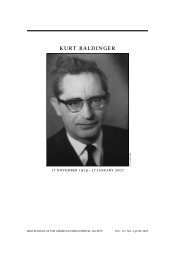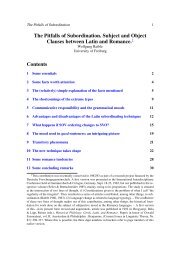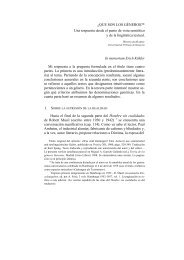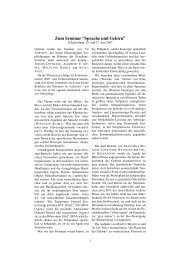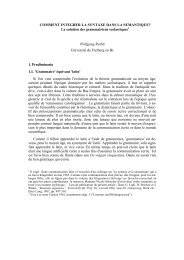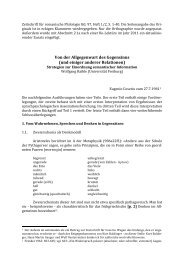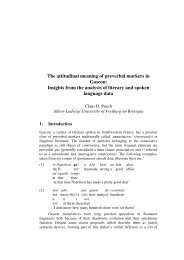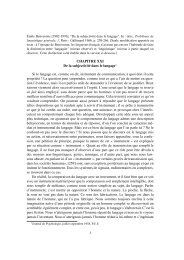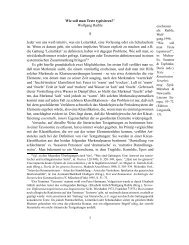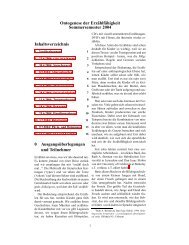A Summary of Role and Reference Grammar
A Summary of Role and Reference Grammar
A Summary of Role and Reference Grammar
Create successful ePaper yourself
Turn your PDF publications into a flip-book with our unique Google optimized e-Paper software.
subordinate clause, e.g. Bill made it to work, even though it was snowing heavily.<br />
r. Temporal<br />
1. Simultaneous states <strong>of</strong> affairs: one state <strong>of</strong> affairs is temporally coterminous with<br />
another, e.g. Max danced <strong>and</strong> Susan played the piano, Kim had chicken pox <strong>and</strong> at<br />
the same time Leslie had the measles.<br />
2. Sequential states <strong>of</strong> affairs: one state <strong>of</strong> affairs follows another temporally, with or<br />
without any temporal overlap, e.g. Juan had finished talking, <strong>and</strong> then Carlos entered<br />
the room, Vidhu was sitting down, <strong>and</strong> the b<strong>and</strong> began to play.<br />
s. Temporally unordered states <strong>of</strong> affairs: the temporal relation between states <strong>of</strong> affairs is<br />
unexpressed, e.g. Tyrone talked to Tanisha, <strong>and</strong> Yol<strong>and</strong>a chatted with Kareem.<br />
These relations may be given a formal characterization in terms <strong>of</strong> the RRG decompositional<br />
system, following a suggestion <strong>of</strong> Ohori (2001); see Ohori (2005) for an alternative formalization.<br />
This is presented in (17).<br />
(17) a. Causative [1] ... CAUSE ...<br />
b. Phase BECOME/INGR, KEEP, TERMINATE<br />
c. Modifying subevents<br />
1. Manner do´ (x, [MOTION´ (x)] ... ∧ [MANNER.OF.MOTION´ (x)])<br />
2. Motion do´ (x, [MOTION´ (x)] ... ∧ [pred2´ (x, (z))])<br />
3. Position do´ (x, [STANCE´ (x)] ∧ [pred2´ (x, (z))])<br />
4. Means do´ (x, [ ... ] ∧ [pred2´ (x, z)])<br />
d. Psych-action MENTAL.DISPOSITION´ (x, [LS ... x ...])<br />
e. Purposive want´ (x, LS2) ∧ DO (x,[ [LS1] ◊ CAUSE [LS2]])<br />
f. Jussive [do´ (x, [say´ (x, y)])] CAUSE [MENTAL.DISP´ (y, [LS ... y ...])]<br />
g. Causative [2] [do´ (x, Ø )] CAUSE [undergo´ (y, [LS ... y ...])]<br />
h. Direct perception PERCEIVE´ (x, [LS ... y ...])<br />
i. Indirect perception PERCEIVE´ (x, [LS])<br />
j. Propositional attitude BELIEVE´ ((x,) [LS])<br />
k. Cognition KNOW´ (x, [LS])<br />
l. Indirect discourse do´ (x, [say´ (x, [LS 〈 TNS ... 〉 ])])<br />
m. Direct discourse do´ (x, [say´ (x, [LS 〈 IF ... 〉 ])])<br />
n. Circumstances be-LOC/TEMP´ ([LS1], [LS2])<br />
o. Reason [LS1] BECAUSE´ [LS2]<br />
p. Conditional [LS1] ⊃ [LS2]<br />
q. Concessive [LS1] IN.SPITE.OF´ [LS2]<br />
r. Temporal [LS1] ∧ [LS2]<br />
[LS1] & [LS2]<br />
s. Situation-Situation [LS1] + [LS2]<br />
A few explanatory notes on these representations are in order. ‘∧’ means ‘<strong>and</strong> simultaneously’,<br />
while ‘&’ means ‘<strong>and</strong> then’; ‘+’ indicates temporally neutral coordination. Causative [1] has the<br />
same LS as a lexical causative verb, e.g. (8g), while Causative [2] involves a matrix LS, the LS<br />
<strong>of</strong> an overt causative verb <strong>and</strong> an embedded LS, as in Kim forced Chris to wash the dishes. See<br />
19



